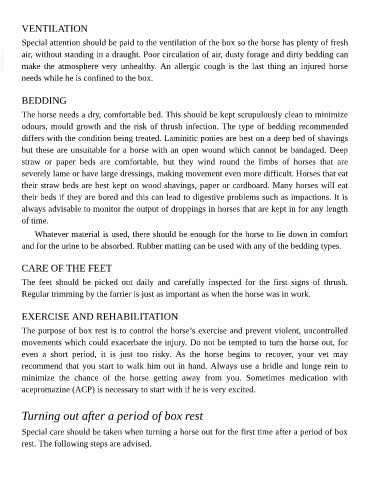Page 1114 - The Veterinary Care of the Horse
P. 1114
VENTILATION
Special attention should be paid to the ventilation of the box so the horse has plenty of fresh
VetBooks.ir air, without standing in a draught. Poor circulation of air, dusty forage and dirty bedding can
make the atmosphere very unhealthy. An allergic cough is the last thing an injured horse
needs while he is confined to the box.
BEDDING
The horse needs a dry, comfortable bed. This should be kept scrupulously clean to minimize
odours, mould growth and the risk of thrush infection. The type of bedding recommended
differs with the condition being treated. Laminitic ponies are best on a deep bed of shavings
but these are unsuitable for a horse with an open wound which cannot be bandaged. Deep
straw or paper beds are comfortable, but they wind round the limbs of horses that are
severely lame or have large dressings, making movement even more difficult. Horses that eat
their straw beds are best kept on wood shavings, paper or cardboard. Many horses will eat
their beds if they are bored and this can lead to digestive problems such as impactions. It is
always advisable to monitor the output of droppings in horses that are kept in for any length
of time.
Whatever material is used, there should be enough for the horse to lie down in comfort
and for the urine to be absorbed. Rubber matting can be used with any of the bedding types.
CARE OF THE FEET
The feet should be picked out daily and carefully inspected for the first signs of thrush.
Regular trimming by the farrier is just as important as when the horse was in work.
EXERCISE AND REHABILITATION
The purpose of box rest is to control the horse’s exercise and prevent violent, uncontrolled
movements which could exacerbate the injury. Do not be tempted to turn the horse out, for
even a short period, it is just too risky. As the horse begins to recover, your vet may
recommend that you start to walk him out in hand. Always use a bridle and lunge rein to
minimize the chance of the horse getting away from you. Sometimes medication with
acepromazine (ACP) is necessary to start with if he is very excited.
Turning out after a period of box rest
Special care should be taken when turning a horse out for the first time after a period of box
rest. The following steps are advised.

